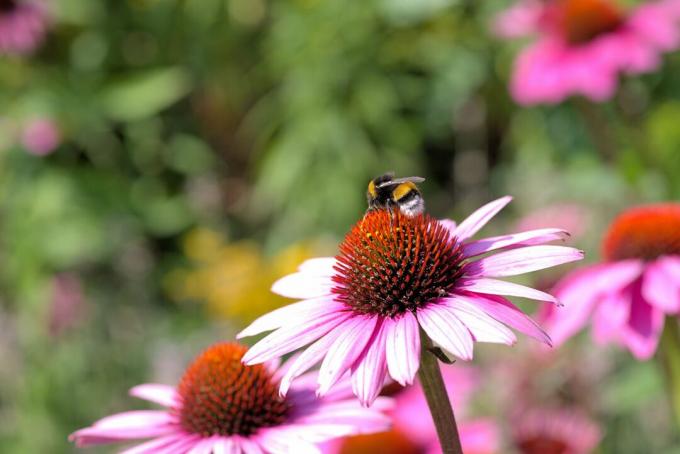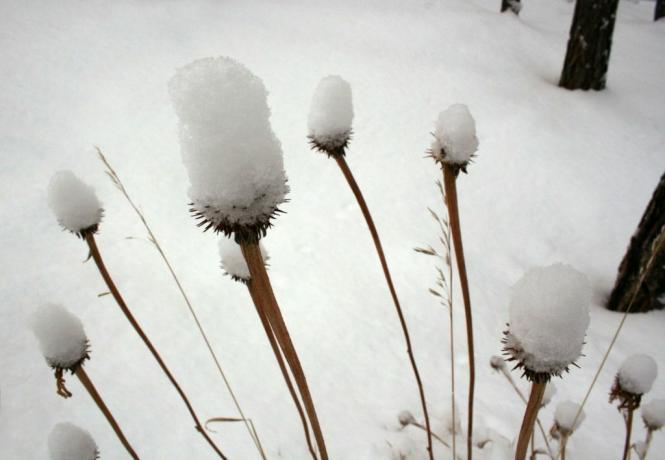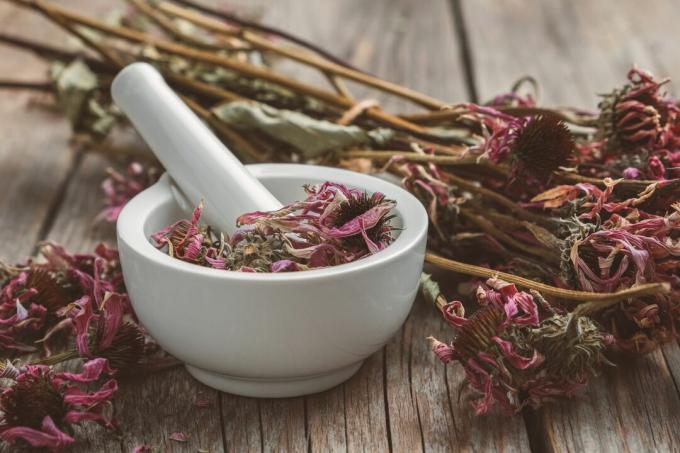The coneflower spreads a summery atmosphere in the garden. Here you can find out everything you need to know about planting, caring for and propagating coneflowers.

The Sun Hats (Echinacea) are also often called hedgehog heads or mock sun hats and beautify every garden with their wonderful and colorful flowers. We will show you here what is important when cultivating coneflowers so that you can enjoy these perennials for a long time.
contents
- Echinacea: origin and characteristics
- Is the coneflower perennial?
- Coneflower species and varieties
- purple coneflower
- Yellow Coneflower
- Buying coneflower plants: This is important to note
- plant coneflowers
- multiply coneflowers
- care for coneflowers
- Water coneflowers
- cutting coneflowers
- Fertilize coneflower
- hibernate coneflowers
- Is coneflower poisonous?
- Echinacea as a medicinal plant
The coneflower is a popular garden perennial and is also perfect for gardening beginners because it is a relatively easy-care plant. You can find out here what you should still bear in mind when caring for sun hats.
Echinacea: origin and characteristics
The purple coneflower belongs to the daisy family of plants (Asteraceae), all types of coneflowers originally come from North America. They can reach a height of 60 to 180 centimeters and usually have taproots with which they can absorb water and nutrients from deeper soil layers. The coneflower forms clumps, because it not only drives out a hairy stalk, but always several stalks. The leaves are also rough and hairy and can grow up to 20 centimeters long.
The flowers have a brownish, prickly center around which the highly arched petals form. These petals are usually pink to purple in color and are very attractive bees and butterflies. There are now specially bred varieties that are whitish or yellow in color. The appearance of the coneflower is very similar to the Rudbeckia (Rudbeckia), but these are a completely different genus. The flowers of the coneflower usually appear in summer from July and can bloom until September. Coneflowers can be sown from March to June.

Is the coneflower perennial?
Coneflowers are perennial herbaceous plants, which means that while they cannot become woody, they can live for several years and usually flower annually as well. Your coneflower can therefore spend the winter outdoors without any problems - you only have to take care of a few things.
Coneflower species and varieties
From a botanical point of view, when we talk about coneflowers, we are always talking about plants from the genus Echinacea, but in our usage there are other plants that look similar and are also called coneflowers, but do not belong to this genus. Here you can learn more about these – sometimes confusing – coneflower species.
purple coneflower
The Purple Coneflower (Echinacea purple), which is also called red mock coneflower, has wonderful large daisy flowers in a crimson color. The purple coneflower prefers a sunny spot with humus-rich soil and flowers from July to September. This species is often used as a medicinal plant for colds or to strengthen the immune system.
Yellow Coneflower
The yellow coneflower is also known as the common coneflower and belongs to the plant genus Rudbeckia (Rudbeckia). This genus also comes from North America and is often used as an ornamental plant. These plants received the name "coneflower" from their yellow flowers, which are reminiscent of the sun, however, they do not belong to the coneflower genus and these plants are not used as medicinal herb.

Buying coneflower plants: This is important to note
In the trade you can either buy the coneflower as seeds in small bags or buy whole coneflower plants. When buying seeds, you should always pay attention to the quality and whether the packaging is still intact, clean and, above all, dry. You will also find a filling or expiry date on the seed sachet. If this date has passed, the germination capacity of the seeds can already be impaired, which means that the seeds can no longer germinate. However, you can also simply harvest coneflower seeds from existing plants in your garden. You can find out what you need to know for this here.
When buying coneflower plants, you should always pay attention to the health of the plants so that you can bring healthy and resilient plants home with you. In addition, of course, nobody wants to introduce pests or diseases with a purchased garden plant. Therefore, before buying, check the plant for signs of damage, eggs from pests such as weevils (Curculionidae) or aphids (Aphidoidea), which are often located on the underside of the leaves, and whether there is a fungal lawn on the leaves or stems. Coneflowers are particularly likely to be attacked and damaged by snails. The purple coneflower is also endangered by mildew fungi being infested, which could then spread to other plants in your garden.
plant coneflowers
A good start is essential so that you can also enjoy your coneflower in the garden. The right location is very important for good growth - for coneflowers this should be a sunny spot without waterlogging. Here in our special article you will find out the most important things about Planting coneflowers.

multiply coneflowers
Echinacea can be propagated in a number of ways - either by seed, by dividing, or vegetatively by cuttings. In our special article on Propagation of coneflowers you will find the most important thing about these three types of propagation and how best to proceed with them.
care for coneflowers
In order to be able to optimally care for the coneflower, you should choose the right location right from the start. As already mentioned, coneflowers thrive best in a sunny spot in your garden. If you only bring the coneflower to a semi-shady place, it will form fewer flowers. During the growing season, it is also advisable to loosen the soil around the coneflower with a garden rake from time to time.
Water coneflowers
Echinacea likes it to be damp, but waterlogging should be avoided at all costs. The plant is best watered in the cool evening hours, but the purple coneflower can also withstand dry periods outdoors - but then it produces fewer flowers. Coneflowers planted in a container should be watered regularly to prevent drying out. Because of their taproots, they can only absorb water from deeper soil layers outdoors.
cutting coneflowers
The coneflower is a very easy-care garden plant, also when it comes to cutting. Of course you can cut off the wonderful flowers in summer and use them to decorate a vase or to make a nice summer bouquet. However, the coneflower must be cut back once a year to promote growth. Here we will tell you what it is all about Cut of sun hats should be noted.

Fertilize coneflower
For optimal growth, coneflowers need nutrient-rich soil that is not too heavy. In addition, it should be more permeable to water for the coneflower to avoid waterlogging. If your soil is too firm, you can apply a mostly organic fertilizer to encourage humus build-up and thereby make the soil more permeable. In the spring, such fertilization for coneflowers outdoors is also optimal. Ours is suitable for this Plantura organic flower fertilizer ideal. If you have planted the coneflower in the bucket, you can also use one liquid fertilizer use to provide nutrients to the plant.
hibernate coneflowers
As already mentioned, the coneflower is perennial and can overwinter outdoors without any problems. In autumn you can even leave the faded stems, to decorate your garden in winter. The underground parts of the coneflower are hardy. In the spring, you simply cut back the above-ground parts of the plant before the new shoots.
It's different with sun hats in the bucket. These are more susceptible to frost, as the bucket itself and the little soil in it cannot provide ideal protection from the cold - that's why it is advisable to always apply frost protection for potted plants or to keep the potted plants indoors for the cold months bring. It is best to place the sun hat on a styrofoam plate so that it is protected from the cold from below. You can also wrap the bucket with garden fleece or protect it with brushwood. This way, your coneflower will get through the winter without any problems and you can enjoy the beautiful perennial again next spring.

Is coneflower poisonous?
The purple coneflower is not poisonous to humans or animals, which is also confirmed by the fact that it has been used as a medicinal plant for a long time and is also used again and again in homeopathy met. So you don't have to worry if your pets chew on the coneflower because there are no toxic ingredients in any part of the plant. The purple coneflower is even safe to eat and many use the aromatic petals in salads or teas. Only use the petals, however, because the center of the flower is prickly, hard and not very tasty.
Echinacea as a medicinal plant
The coneflower is not only known as a wonderful ornamental plant, but has certainly come across a few who had a cold or were looking for a remedy to boost their immune system during flu season strengthens. The coneflower was already used by the Native Americans as a medicinal plant for sore throats and coughs.
Today, the following three types of coneflowers are mainly used for diseases of the respiratory and urinary tract:
- Echinacea purpurea
- Echinacea pallida
- Echinacea angustifolia

The effect of coneflower products as a remedy is controversial, because many studies have been carried out with very different results. Despite everything, coneflower is often used in homeopathy. The pressed juice of the coneflower and a tincture and extracts from it are also used and are said to strengthen the immune system, have an anti-inflammatory effect and be antibacterial.
